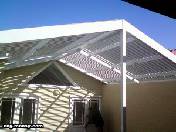Modern Construction Methods Used In Metal Louvers Roofs 3 From 4

This gives panels their characteristic soft edge, but they look smooth and consistent, and this is usually accepted visual apart of their appearance.
If much thicker sheet is used, there is a disadvantage in increased cost as well as a greater difficulty in working the sheet to form smooth shaped pressed panels.
Aluminum panels are typically either PVDF coated or polyester powder coated, while steel sheet is usually polyester powder coated only.
The use of anodized aluminum as a finish on sheet has increased in recent years as a result of greater reliability of the finish, which until recently has suffered from uneven color consistency.
The silicone used to seal the joints can be applied in a variety of monotone tints, ranging from white, to grays, to black Some silver-grey colors match well with silver colored panels to give an overall appearance of a single color for the complete canopy, particularly when recessed joints are used between panels.
Flush joints in silicone tend to give the canopy surface an homogenous appearance, giving it more the appearance of concrete than of metal.
This can detract from the crisply fitted assembly of panels which is characteristic of metal and also one of the advantages of the material.
Louvers are typically a maximum of around 6000 mm long for those 75 mm to l00 mm deep.
requiring support at 1000mm to 1500mm.
Sliding arms typically support up to a 6000mmlength of Louvre blades, giving an overall square shape(in plan) to each set of controlled Louvers of 6000mm x 6000mm size which are fixed into the supporting I-section frame.
A 100 mm deep I-section will span typically 1000 mm- I500 mm between supports depending on the design of the glazed roof below.



